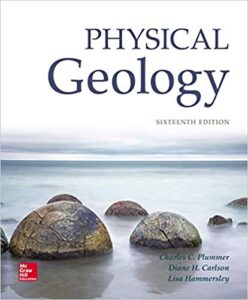Description
Test Bank For Physical Geology 16th Edition by Charles (Carlos) Plummer
Chapter 4 Volcanism and Extrusive Rocks
1) Measurements indicate that the worldwide average temperature dropped about a half degree Celsius for a couple of years after the eruption of Mt. St. Helens.
2) Weathered volcanic ash and lava produce excellent fertile soils.
3) Major volcanic peaks of the Cascade Mountains, like Mt. Rainier, Mt. Shasta, Mt. Hood, and Mt. St. Helens, have been active volcanoes for 30 to 40 million years.
4) Tsunamis account for most fatalities in volcanic eruptions.
5) The original volcano Mount Mazama erupted to form Crater Lake, Oregon.
6) Silicic lavas, which are relatively high in silica, tend to be more fluid than mafic magmas.
7) Most of the gas released by volcanic eruptions is sulfur dioxide.
8) Volcanic rocks, and the magma from which they formed, have a silica content that ranges from 45% to 75% by volume.
9) Basalt is a variety of gabbro.
10) Tuff is a rock composed of fine-grained pyroclastic particles.
11) Basalt is the most common mafic rock.
12) Pahoehoe lava flow is characterized by a ropy or billowy surface.
13) Volcanic domes are steep-sided domes or spine-shaped masses of volcanic rock formed from viscous lava that solidifies in or immediately above a volcano’s vent.
14) Columnar jointing is a characteristic of basalt lava.
15) Pillow structures, pillow-shaped rounded masses, form where lava is extruded under water.
16) Composite volcanoes are also called cinder cone volcanoes.
17) Earth is the only major body in the solar system on which there are active volcanoes.
18) Rhyolite is a fine-grained extrusive rock composed of feldspar with some quartz.
19) The islands of Hawaii are essentially a series of shield volcanoes built upward from the ocean floor over millions of years.
20) Volcanic eruptions have no effect on climate.
21) The last volcano to erupt in the continental 48 states was ________.
- A) Mount Garibaldi
- B) Mount Rainier
- C) Mount Mazama
- D) Mount St. Helens
- E) Mount Fuji
22) The term ________ is used for molten rock on the Earth’s surface.
- A) lava
- B) tuff
- C) magma
- D) tephra
- E) cinder
23) A(n) ________ is a mix of gas and dust emitted by a volcano that is so dense that it hugs the ground.
- A) pyroclastic flow
- B) pahoehoe flow
- C) obsidian
- D) lava flow
- E) tuff flow
24) Condensation of the water vapor by degassing magma during the time following Earth’s formation produced the ________.
- A) atmosphere
- B) geosphere
- C) hydrosphere
- D) magnetosphere
- E) biosphere
25) The islands of the Hawaiian chain are an excellent example of a series of ________.
- A) cinder cones
- B) composite volcanoes
- C) spatter cones
- D) shield volcanoes
- E) strata volcanoes
26) ________ are tunnel-like caves within a lava flow.
- A) Pores
- B) Vesicles
- C) Lava tubes
- D) Lava pipes
- E) Calderas
27) Shield volcanoes have ________ bases and ________ inclined slopes.
- A) broad; steeply
- B) broad; gently
- C) narrow; steeply
- D) narrow; gently
28) Occasionally, a volcano will spew large amounts of fine volcanic dust into the high atmosphere. This dust can have the effect of ________.
- A) reducing the sunlight that reaches Earth’s surface, suppressing photosynthetic processes
- B) reducing Earth’s surface temperature
- C) damaging aircraft that fly through the dust
- D) causing unusual weather
- E) All of the answers are correct.
29) What are the three factors that influence viscosity of a lava?
- A) depth of magma, temperature, ease of gas escaping to atmosphere
- B) amount of gas, rhyolite, and vesicles in the magma
- C) origin of the magma, plate tectonic setting, condensation
- D) plate tectonic setting, thickness of the geosphere, amount of gas in the magma
- E) silica content, temperature, dissolved gases
30) A ________ is a mixture of gas and pyroclastic debris that is so dense that it hugs the ground as it flows rapidly into low areas.
- A) silica flow
- B) lava flow
- C) pyroclastic flow
- D) change in viscosity
- E) pahoehoe lava flow

Reviews
There are no reviews yet.